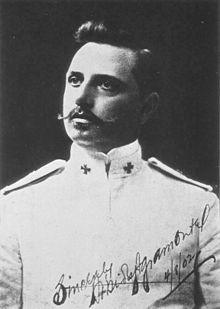
KNOWPIA
WELCOME TO KNOWPIA
Summary
Aristides Agramonte y Simoni (June 3, 1868 – August 19, 1931) was a Cuban American physician, pathologist and bacteriologist with expertise in tropical medicine. In 1898 George Miller Sternberg appointed him as an Acting Assistant Surgeon in the U.S. Army and sent him to Cuba to study a yellow fever outbreak.[1] He later served on the Yellow Fever Commission, a U.S. Army Commission led by Walter Reed which examined the transmission of yellow fever.[2][3]
Aristides Agramonte | |
|---|---|
 Aristides Agramonte | |
| Born | June 3, 1868 |
| Died | August 19, 1931 |
| Nationality | American |
| Known for | Yellow fever |
| Scientific career | |
| Fields | bacteriology |
| Institutions | University of Havana |

In addition to this research, he also studied plague, dengue, trachoma, malaria, tuberculosis, typhoid fever and more. After serving on the Yellow Fever Commission, he served as a professor at the University of Havana as well as many government positions.[4][5]
See also edit
References edit
- ^ "Yellow Fever & and the Reed Collection: The Walter Reed Yellow Fever Commission in Cuba". University of Virginia Health Sciences Library. Archived from the original on 2014-08-27.
- ^ Pierce, John R (Nov 2003), ""In the interest of humanity and the cause of science": the yellow fever volunteers", Military Medicine, vol. 168, no. 11, pp. 857–63, PMID 14680037
- ^ Anonymous (September 2001), "Biography of Aristides Agramonte", Military Medicine, vol. 166, no. Suppl 1, p. 23, doi:10.1093/milmed/166.suppl_1.23, PMID 11569380
- ^ "Association News: Dr Agramonte an Honorary Fellow". American Journal of Public Health and the Nation's Health. 20 (12): 1333–1342. 1930. doi:10.2105/AJPH.20.12.1333. PMC 1556161.
- ^ "Aristides Agramonte, M. D. (Obituary)", American Journal of Public Health and the Nation's Health, vol. 21, no. 10, pp. 1136–7, October 1931, doi:10.2105/AJPH.21.10.1136, PMC 1556463, PMID 18013369
Publications edit
- Agramonte, Aristides (1900). "Report of Bacteriological Investigations upon Yellow Fever". The Medical News. 76 (6): 203–212.
- Reed, W.; Carroll, J.; Agramonte, A.; Lazear, J.W. (1900). "The Etiology of Yellow Fever-A Preliminary Note". Public Health Pap Rep. 26: 37–53. PMC 2329228. PMID 19600960.
- Reed, W.; Carroll, J.; Agramonte, A. (1901). "Experimental yellow fever". American Medicine. 2 (1): 1–15.
- Reed, W.; Carroll, J.; Agramonte, A. (1901). "The etiology of yellow fever : An additional note". Journal of the American Medical Association. 36 (7): 431–440. doi:10.1001/jama.1901.52470070017001f. Reprinted by the Journal in 1983: Reed, W.; Agramonte, A. (1983), "Landmark article. Feb 16, 1901: The etiology of yellow fever. An additional note", JAMA, vol. 250, no. 5, pp. 649–58, doi:10.1001/jama.250.5.649, PMID 6345833
- Agramonte, Aristides (1915). "The Inside History of a Great Medical Discovery". The Scientific Monthly. 1 (3): 209–237. Bibcode:1915SciMo...1..209A.
External links edit
- University of Virginia Health Sciences Library: A Guide to the Philip S. Hench Walter Reed Yellow Fever Commission This extensive collection includes 154 boxes of items.


